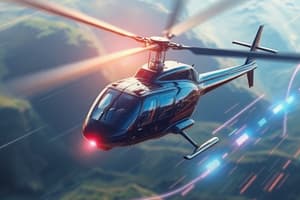Podcast
Questions and Answers
What is the primary focus of the innovations discussed in Cool Science: Paper airplanes, insect wings, and the future of tiny drones?
What is the primary focus of the innovations discussed in Cool Science: Paper airplanes, insect wings, and the future of tiny drones?
- Improving human-controlled flight technology.
- The development of static flying structures.
- Enhancing traditional aircraft design.
- The evolution of miniature flying devices inspired by nature. (correct)
How does the study of insect wings contribute to technological advancements in drone design?
How does the study of insect wings contribute to technological advancements in drone design?
- It offers insights into energy-efficient processes. (correct)
- It provides models for larger commercial drones.
- It suggests materials for building high-speed vehicles.
- It reveals structural designs for stationary objects.
Which of the following is NOT mentioned as a topic of exploration in the content?
Which of the following is NOT mentioned as a topic of exploration in the content?
- The future applications of tiny drones.
- The comparison of drone speeds and altitudes.
- The physiology of various insect species. (correct)
- The mechanics of paper airplanes.
What potential benefit do tiny drones have as explored in the content?
What potential benefit do tiny drones have as explored in the content?
What aspect of paper airplanes is highlighted in the content as beneficial to understanding flight?
What aspect of paper airplanes is highlighted in the content as beneficial to understanding flight?
Flashcards are hidden until you start studying
Study Notes
Central Idea of Cool Science: Paper airplanes, insect wings, and the future of tiny drones
- The study of aerodynamics through paper airplanes provides insights into flight mechanics.
- Insect wings are examined for their unique structures, enabling highly efficient and agile flight.
- Innovations in drone technology are drawing inspiration from natural flyers, aiming to enhance performance and design.
- The research explores scalability, aiming to develop tiny drones for various applications, such as surveillance and environmental monitoring.
- Biomimicry, the practice of emulating nature's designs, is a key principle driving advancements in drone engineering.
- The future of tiny drones is linked to increased autonomy, improved maneuverability, and advanced sensing capabilities, mirroring the adaptability of insects.
- Collaboration between scientists and engineers is crucial in bridging biological principles and technological innovations.
Studying That Suits You
Use AI to generate personalized quizzes and flashcards to suit your learning preferences.




